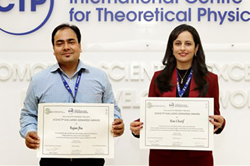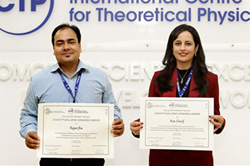Winter College on Optics looks at light-based applications in Earth and Space


TRIESTE, Italy, and BELLINGHAM, Washington, USA (PRWEB) March 13, 2015
Apropos for the International Year of Light, the 2015 Winter College on Optics in Trieste followed the theme “Light: a Bridge between Earth and Space.” The college drew 93 participants from 33 countries and ran 9-20 February at the Abdus Salam International Centre for Theoretical Physics (ICTP). SPIE, the international society for optics and photonics, is a co-sponsor of the annual event, along with the International Commission for Optics (ICO) and several other organizations.
This year, 47% of participants were male and 53% female, organizers reported.
Directors were Angela Piegari (Optical Coatings Laboratory-ENEA), Errico Armandillo (European Space Agency), and W. Chen (Shanghai Institute of Optics and Fine Mechanics. Local organizers were Joe Niemela (ICTP) and Miltcho Danailov (Elettra).
Main topics covered by faculty included:
Optical components and systems
Photonic components and sensors
Optical instruments
Passive and active instrumentation
Optical atomic clocks, cooled atom physics, laser guide stars
Space satellite applications and missions: meteorology, climatology, atmospheric research, geodesy, gravimetry, astronomy, telecom, navigation, cosmology, planetology, etc.
Space optics project phasing: from concept to launch and exploitation.
The Winter College LAMP (Laser, Atomic and Molecular Physics) program provides participants with an opportunity to present their work in poster form or as a short oral presentation, with Best Paper prizes awarded by SPIE.
SPIE Past President Katarina Svanberg presented the awards on behalf of SPIE, including two first prizes to:
Cristine Calil Kores of the Instituto de Pesquisas Energéticas e Nucleares, for “LD-side-pumped Nd:YVO4 sel- Raman laser at 1176 nm”
Jehan Abkar of the University of Glasgow, for “High-power mode-locked lasers with intergraded SOAs.”
The 2015 ICO/ICTP Gallieno Denardo Prize recognizing young researchers from developing countries was awarded to two recipients:
Rim Cherif (SUP COM, Tunisia) for her work in nonlinear fiber optics and applications
Rajan Jha (India) for his work with photonics crystal fiber-based sensors.
Svanberg and SPIE Past President María Yzuel (Universidad Autònoma de Barcelona) represented SPIE at a meeting on 18 February of the Trieste System Optical Sciences and Applications (TSOSA) Advisory Group, which advises on the coordination of ICTP activities in optics and photonics.
In addition to supporting the Winter College on Optics with an annual $ 5,000 contribution, SPIE provides $ 30,000 annually to support an optics staff position in the SPIE-ICTP Anchor Research in Optics Program.
The program recently moved to the ICTP campus and, using funds from the Applied Physics/Turbulence Lab at Elettra, has purchased equipment that can be applied in ongoing optical tweezers research or other areas of microscopy, particularly thermal lens microscopy.
In conjunction with ICTP, SPIE provides free SPIE Digital Library access in participating countries through the eJDS (eJournals Delivery Service) program. Articles from scientific literature, primarily in physics and mathematics, are provided to individual scientists.
About SPIE
SPIE is the international society for optics and photonics, a not-for-profit organization founded in 1955 to advance light-based technologies. The Society serves nearly 256,000 constituents from approximately 155 countries, offering conferences, continuing education, books, journals, and a digital library in support of interdisciplinary information exchange, professional networking, and patent precedent. SPIE provided more than $ 3.4 million in support of education and outreach programs in 2014. http://www.spie.org